Giáo án Tiếng Anh Lớp 8 - Chương trình cả năm - Trần Quốc Tuấn
I> Objectives: After this lesson student can be able to:
-Rivise the main contents that they continue learning in grade 8
-Help them selves systemetically consolidate what they have learnt in grade 7 and continue being better in grade 8
II> Language contents:
1> Present simple tense
2> Adjectives and Adverbs
3> Vocabulary: some verbs like : collect, read, go, write, swim
III> Teaching method : Communicative and Drill Method
IV> Teaching Aids: text book , exercises
V> Time: 45 minutes
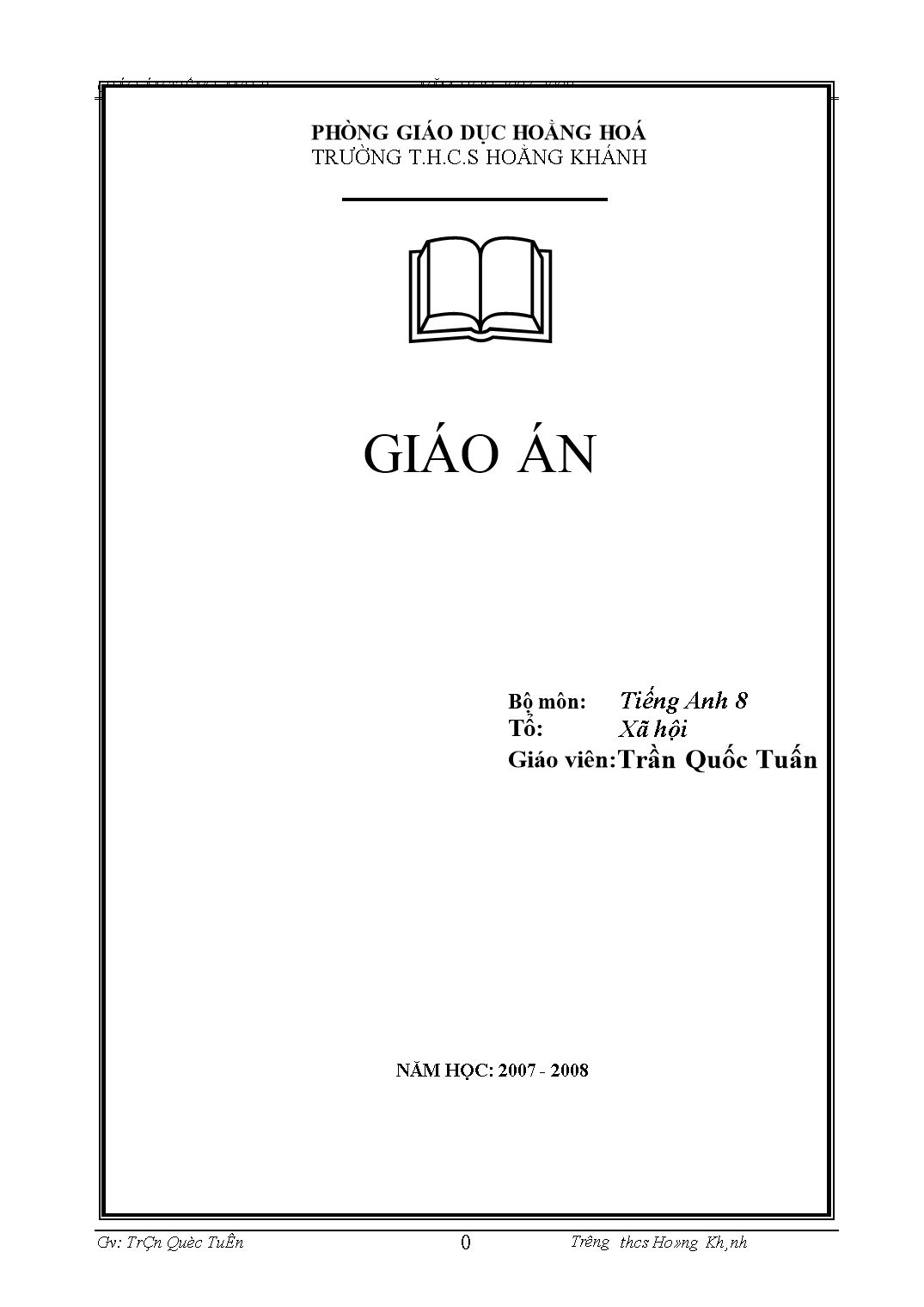
Trang 1
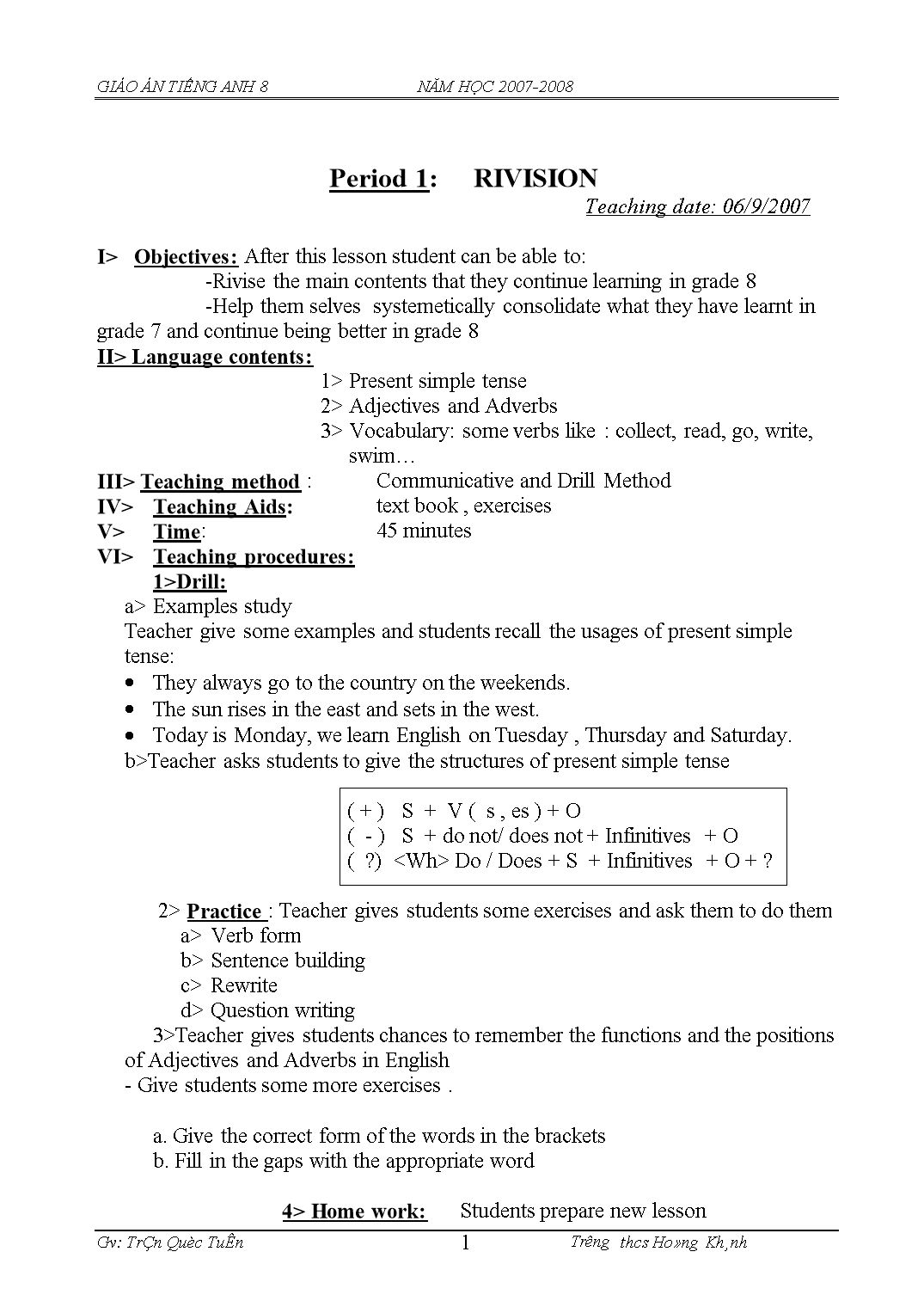
Trang 2
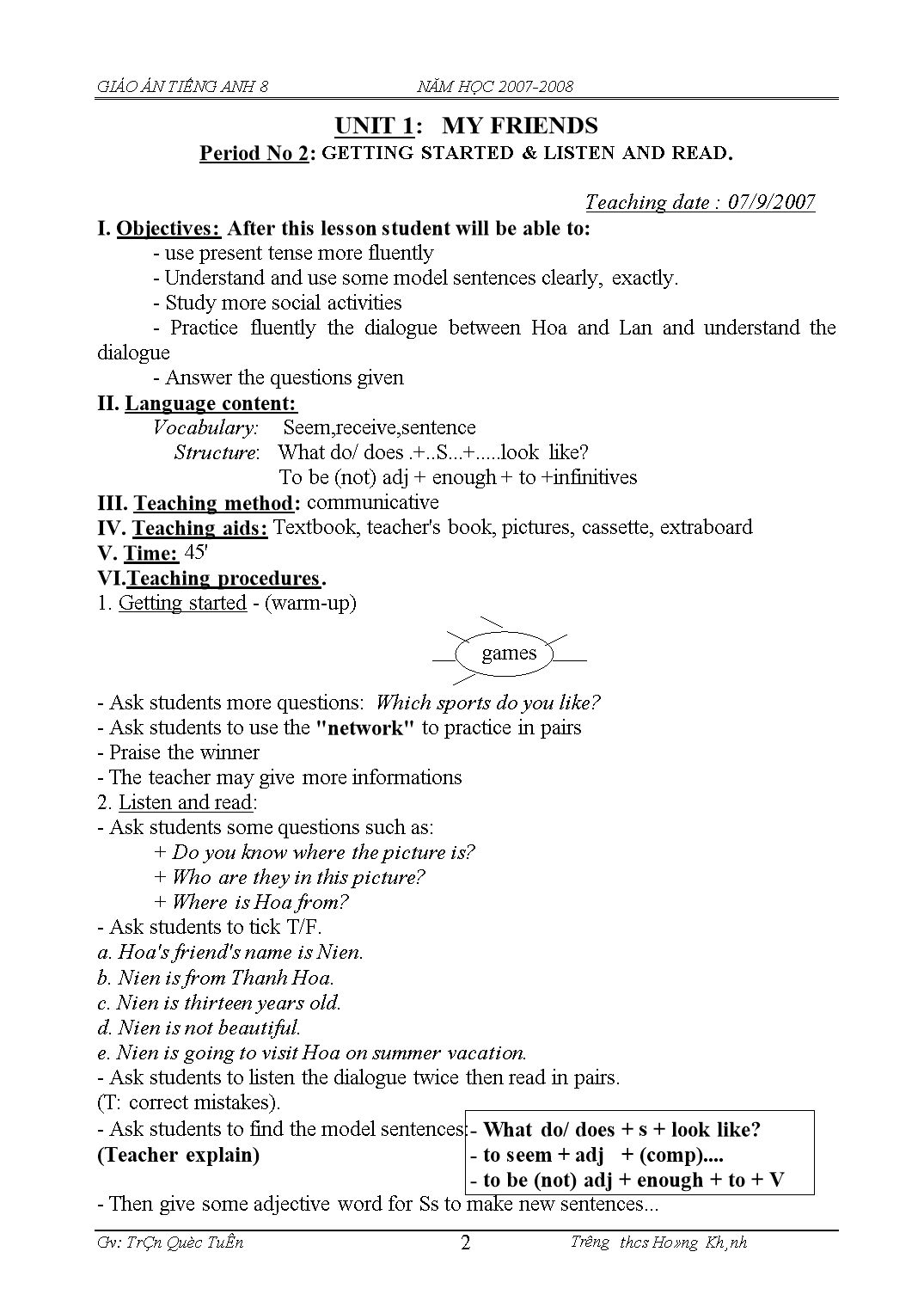
Trang 3
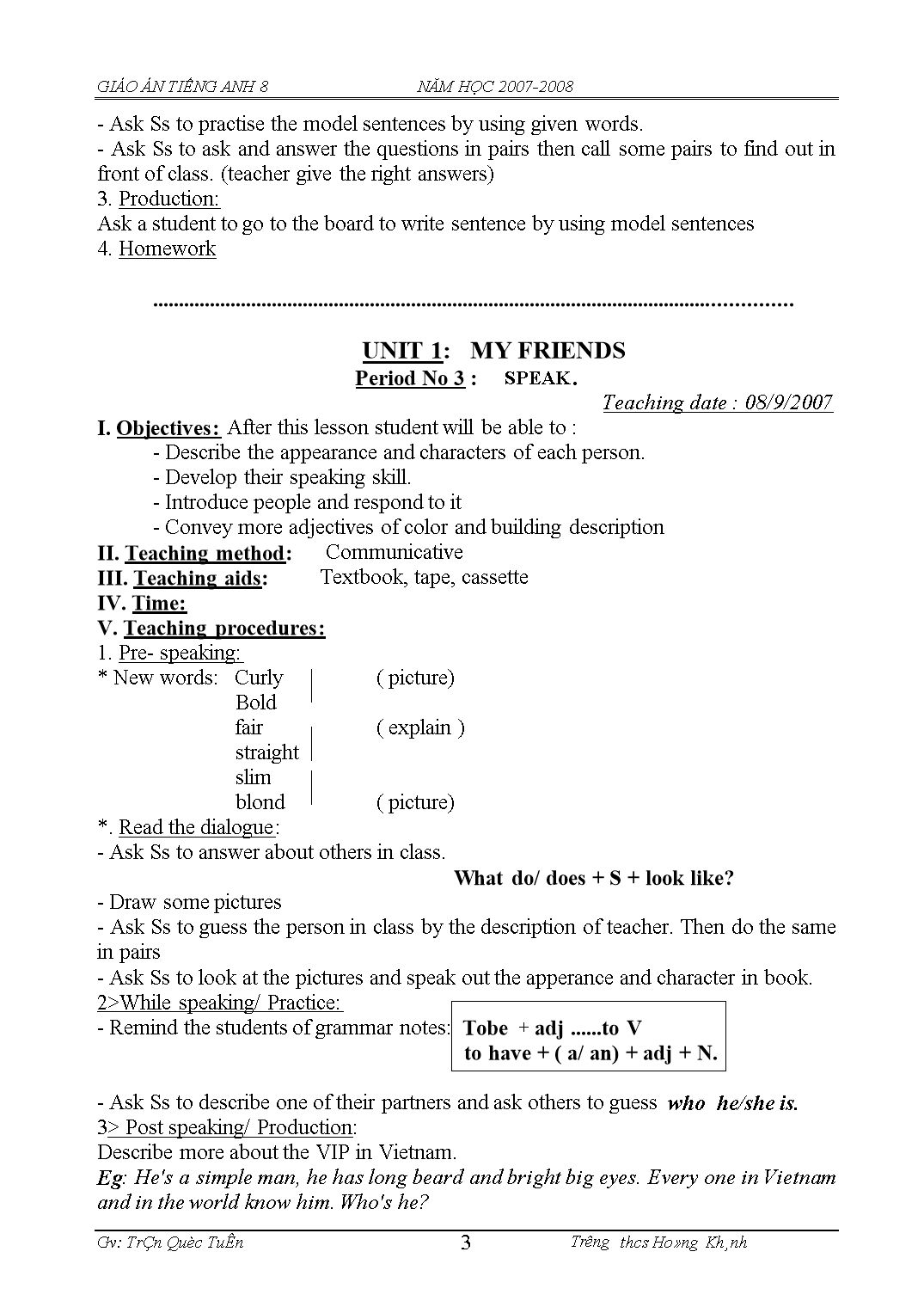
Trang 4
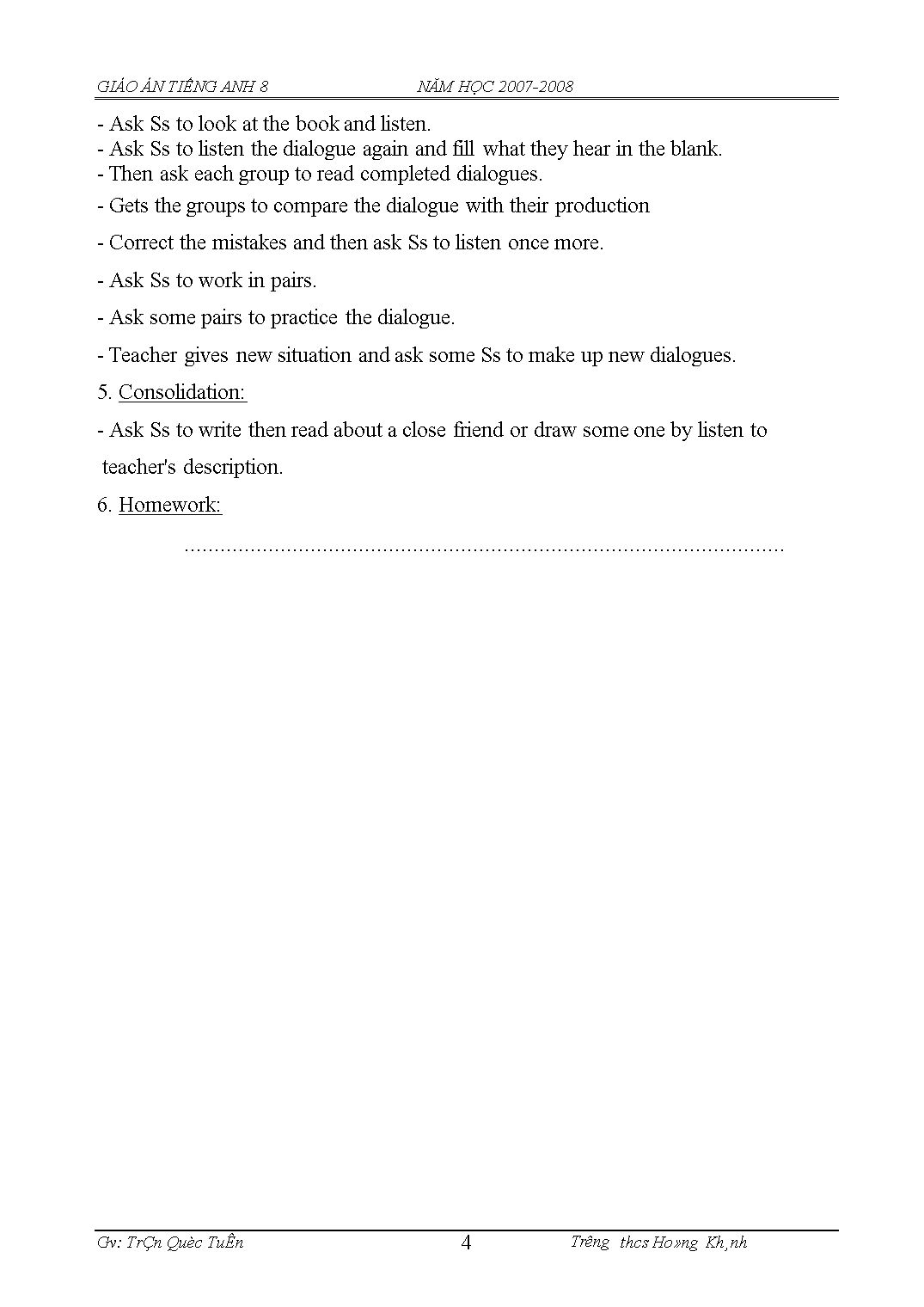
Trang 5
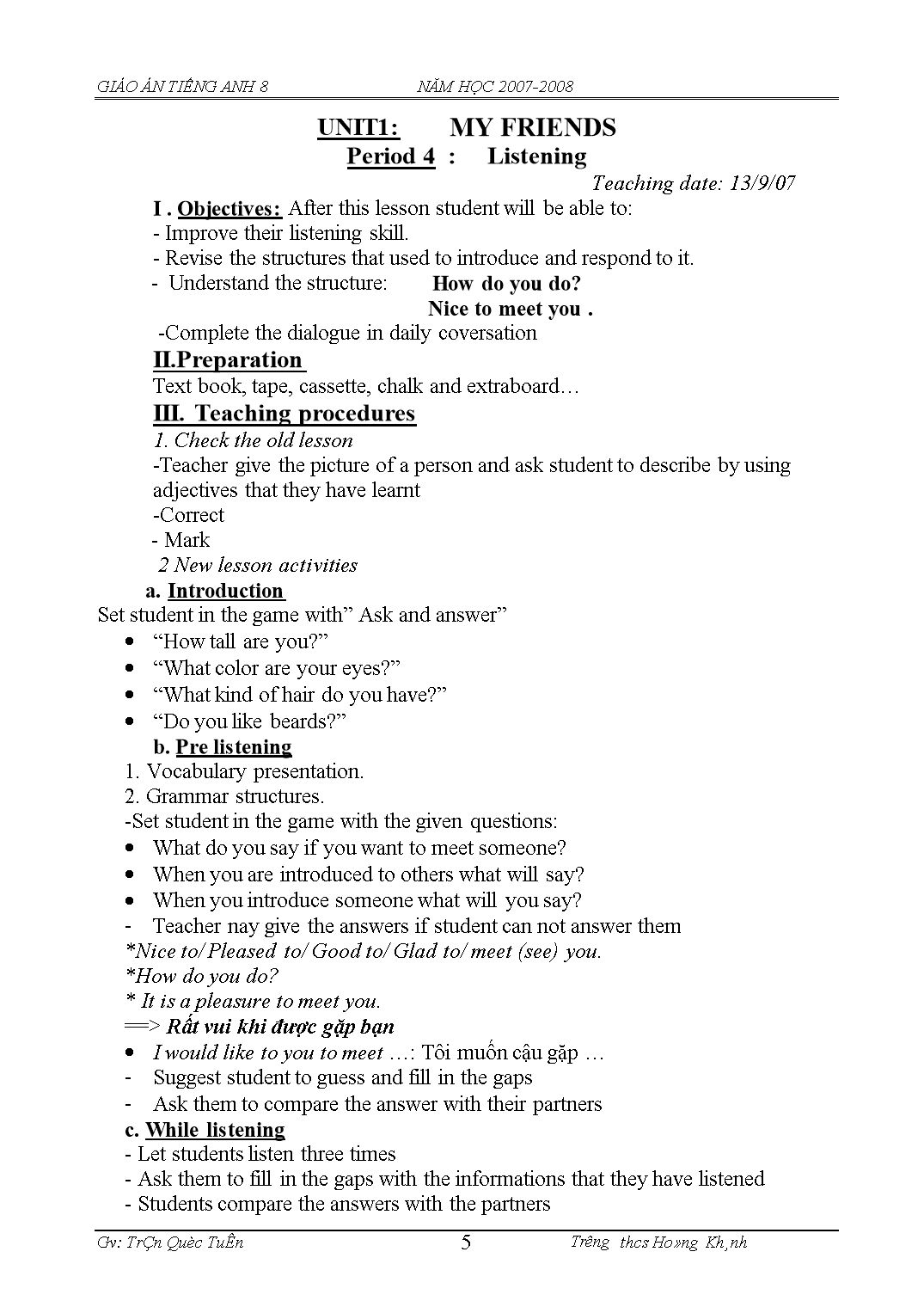
Trang 6
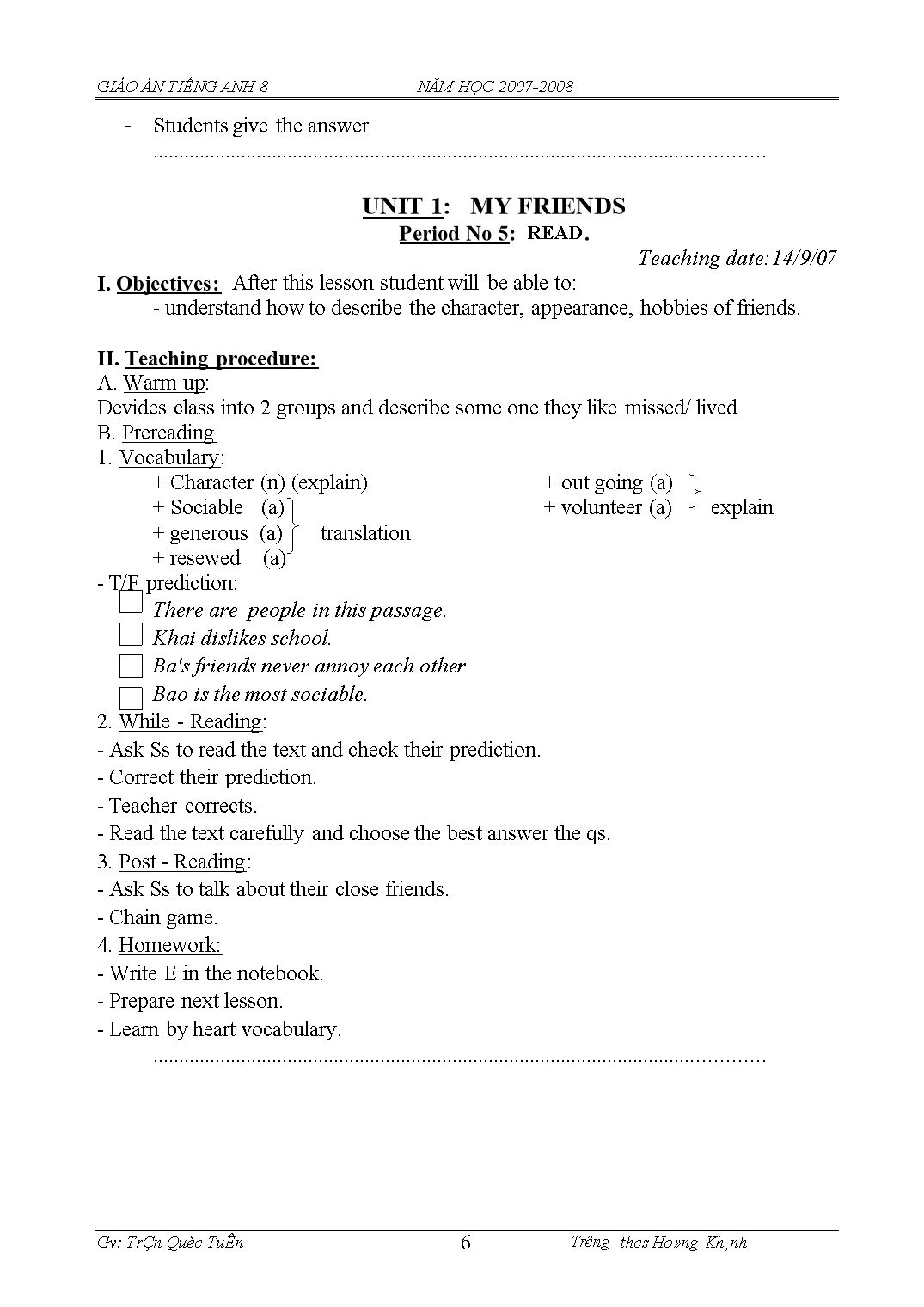
Trang 7
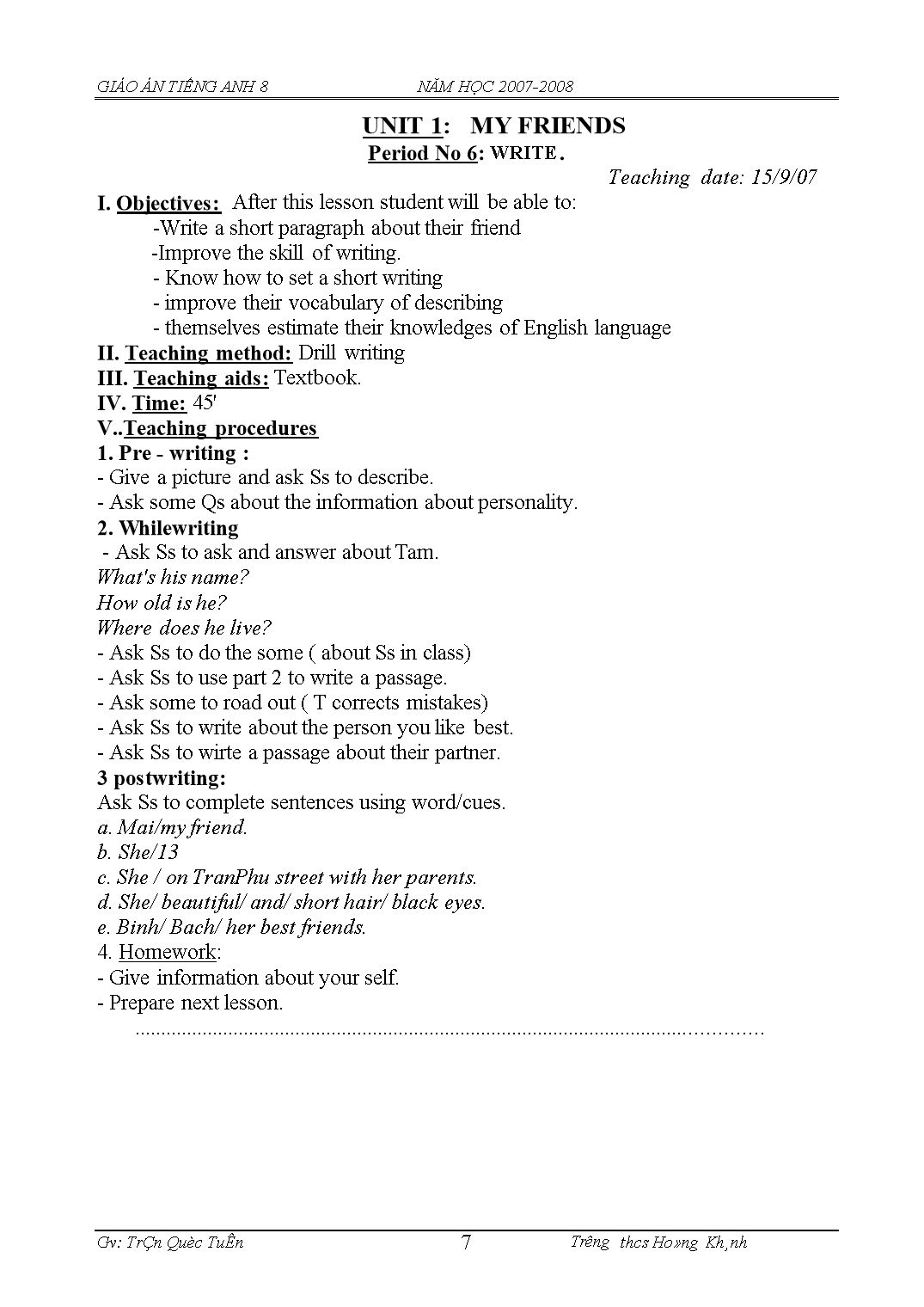
Trang 8
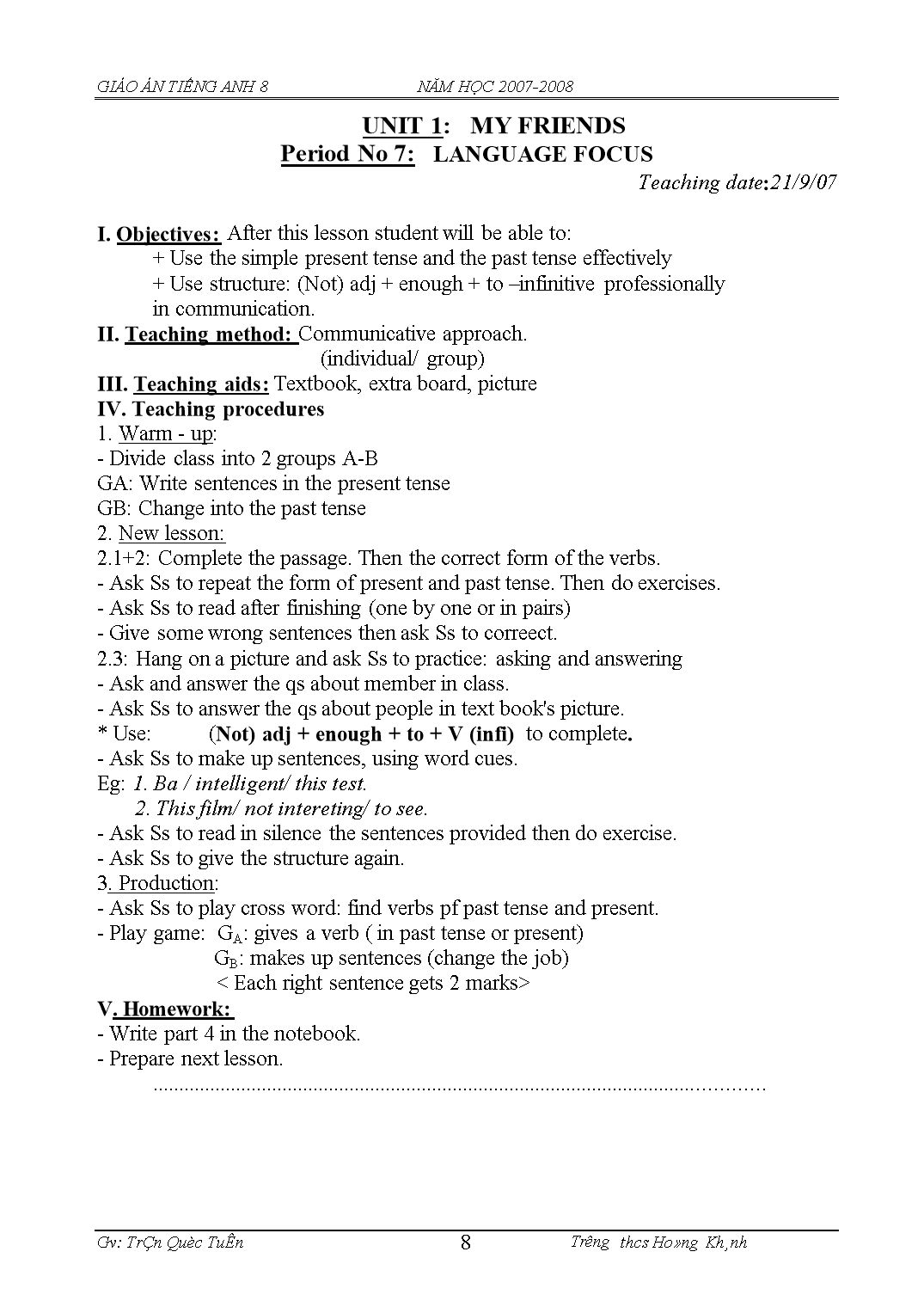
Trang 9
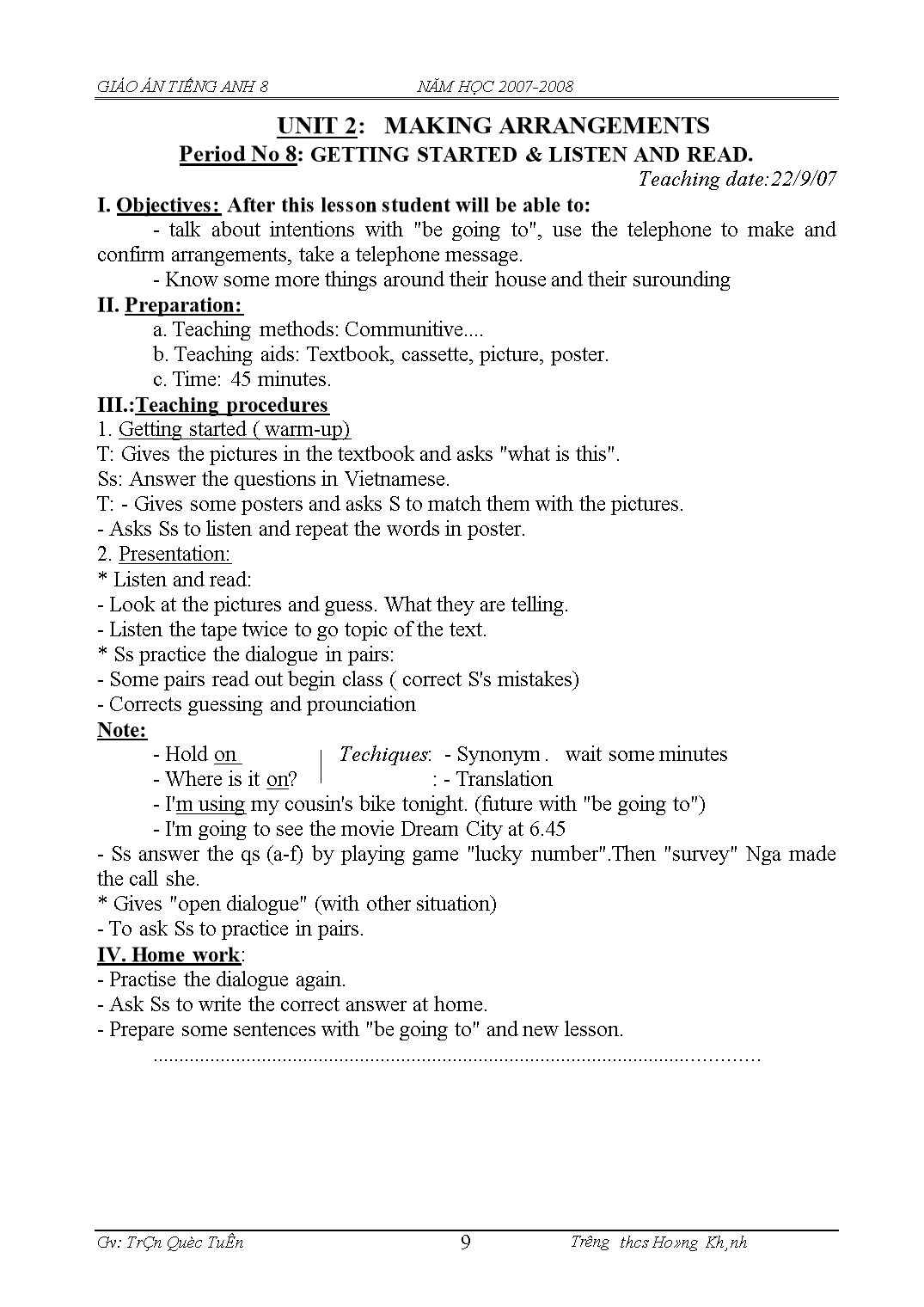
Trang 10
Tải về để xem bản đầy đủ
Bạn đang xem 10 trang mẫu của tài liệu "Giáo án Tiếng Anh Lớp 8 - Chương trình cả năm - Trần Quốc Tuấn", để tải tài liệu gốc về máy hãy click vào nút Download ở trên
Tóm tắt nội dung tài liệu: Giáo án Tiếng Anh Lớp 8 - Chương trình cả năm - Trần Quốc Tuấn
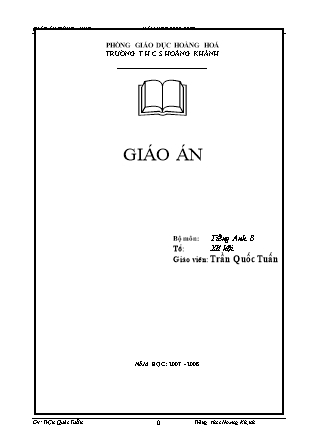
PHÒNG GIÁO DỤC HOẰNG HOÁ TRƯỜNG T.H.C.S HOẰNG KHÁNH & GIÁO ÁN Bộ môn: Tiếng Anh 8 Tổ: Xã hội Giáo viên:Trần Quốc Tuấn NĂM HỌC: 2007 - 2008 Period 1: RIVISION Teaching date: 06/9/2007 I> Objectives: After this lesson student can be able to: -Rivise the main contents that they continue learning in grade 8 -Help them selves systemetically consolidate what they have learnt in grade 7 and continue being better in grade 8 II> Language contents: Present simple tense Adjectives and Adverbs Vocabulary: some verbs like : collect, read, go, write, swim III> Teaching method : Communicative and Drill Method Teaching Aids: text book , exercises Time: 45 minutes Teaching procedures: 1>Drill: Examples study Teacher give some examples and students recall the usages of present simple tense: They always go to the country on the weekends. The sun rises in the east and sets in the west. Today is Monday, we learn English on Tuesday , Thursday and Saturday. b>Teacher asks students to give the structures of present simple tense ( + ) S + V ( s , es ) + O ( - ) S + do not/ does not + Infinitives + O ( ?) Do / Does + S + Infinitives + O + ? 2> Practice : Teacher gives students some exercises and ask them to do them Verb form Sentence building Rewrite Question writing 3>Teacher gives students chances to remember the functions and the positions of Adjectives and Adverbs in English - Give students some more exercises . a. Give the correct form of the words in the brackets b. Fill in the gaps with the appropriate word 4> Home work: Students prepare new lessonUNIT 1: MY FRIENDS Period No 2: GETTING STARTED & LISTEN AND READ. Teaching date : 07/9/2007 I. Objectives: After this lesson student will be able to: - use present tense more fluently - Understand and use some model sentences clearly, exactly. - Study more social activities - Practice fluently the dialogue between Hoa and Lan and understand the dialogue - Answer the questions given II. Language content: Vocabulary: Seem,receive,sentence Structure: What do/ does .+..S...+.....look like? To be (not) adj + enough + to +infinitives III. Teaching method: communicative IV. Teaching aids: Textbook, teacher's book, pictures, cassette, extraboard V. Time: 45' VI.Teaching procedures. 1. Getting started - (warm-up) games - Ask students more questions: Which sports do you like? - Ask students to use the "network" to practice in pairs - Praise the winner - The teacher may give more informations 2. Listen and read: - Ask students some questions such as: + Do you know where the picture is? + Who are they in this picture? + Where is Hoa from? - Ask students to tick T/F. a. Hoa's friend's name is Nien. b. Nien is from Thanh Hoa. c. Nien is thirteen years old. d. Nien is not beautiful. e. Nien is going to visit Hoa on summer vacation. - Ask students to listen the dialogue twice then read in pairs. (T: correct mistakes). - Ask students to find the model sentences:- What do/ does + s + look like? (Teacher explain) - to seem + adj + (comp).... - to be (not) adj + enough + to + V - Then give some adjective word for Ss to make new sentences... - Ask Ss to practise the model sentences by using given words. - Ask Ss to ask and answer the questions in pairs then call some pairs to find out in front of class. (teacher give the right answers) 3. Production: Ask a student to go to the board to write sentence by using model sentences 4. Homework .......................................................................................................................... UNIT 1: MY FRIENDS Period No 3 : SPEAK. Teaching date : 08/9/2007 I. Objectives: After this lesson student will be able to : - Describe the appearance and characters of each person. - Develop their speaking skill. - Introduce people and respond to it - Convey more adjectives of color and building description II. Teaching method: Communicative III. Teaching aids: Textbook, tape, cassette IV. Time: V. Teaching procedures: 1. Pre- speaking: * New words: Curly ( picture) Bold fair ( explain ) straight slim blond ( picture) *. Read the dialogue: - Ask Ss to answer about others in class. What do/ does + S + look like? - Draw some pictures - Ask Ss to guess the person in class by the description of teacher. Then do the same in pairs - Ask Ss to look at the pictures and speak out the apperance and character in book. 2>While speaking/ Practice: - Remind the students of grammar notes: Tobe + adj ......to V to have + ( a/ an) + adj + N. - Ask Ss to describe one of their partners and ask others to guess who he/she is. 3> Post speaking/ Production: Describe more about the VIP in Vietnam. Eg: He's a simple man, he has long beard and bright big eyes. Every one in Vietnam and in the world know him. Who's he? - Ask Ss to look at the book and listen. - Ask Ss to listen th ... agree/ I don’t agree) - Present other ways to talk about agreement and contract to. So do I = I agree I disagree = I don’t agree. - Guide Ss to practice speaking with example of part 1 - Hang the pictures on the board and ask Ss to find the words to talk about these activities. Picture a: Driving/ learning to drive a car/ challenging/ easy/ different. Picture b: Comic books/ boring/ interesting. Picture c: Walking in the rain/ fun.. Picture d: Hambergers/ Soda/ delicious/ unhealthy. 3. While-speaking: - Explain the request of part 1 - Ask Ss to work in groups/ pairs to give their opinion about these activities using eliciting words. - Ask the groups/ pairs to present their dialogues. - Present the situation of part 2. - Call some pairs to read the dialogues. - Ask Ss to make similar dialogues using the information in the table ( work in pairs) - Call Ss to present their dialogues in front of the class. 4. Post-speaking: - Give words cues and Ss to make dialogues base on these words. Ex: Motorbike/ start/ broken/ open the key. - Ask Ss to work in pairs asking and answering with “Do you think.?” “Do you like .?” 5. Homework: - Ask Ss to rewrite the dialogues in exercise book. - Practice speaking by ask her family members. - Prepare for next lesson. UNIT 15 COMPUTERS Period No 94: LISTEN. Teaching date:. I. Objectives: - By the end of the lesson, Ss will be able to improve listening skill. II. Materials: III. Teaching methods: Communicative. IV. Ways of work: - Pairs, group work. V. Procedures: 1. Pre-listening: - Ask them to copy the chart into their exercise book. - Ask them to guess the missing words. 2. While-listening: - Let them listen to the record player twice. - Ask them to complete the chart. - Check and correct. - Let them listen one more to check again. Pre-teach: press button, sequenced, circle, triangle, indicate, oral. Key: a. Do you have a correct change? b. Yes c. Do you want to drink? d. Take it from the machine. 3. Homework: - Learn by heart new words. - Do exercises in book. - Prepare new lesson. .. UNIT 15 COMPUTERS Period No 95: READ. Teaching date:. I. Objectives: - By the end of the lesson, Ss will be able to understand the advantages of computers. - Develop Ss’ reading skill. II. Language contents: 1. Vocabulary: degree, freshman, skeptical, restrict. 2. Structure: Present perfect. III. Teaching methods: Communicative. IV. Teaching aids: - Text book, extre-board,.. V. Procedures: save time Advantages of Computers 1. Warm-up: send and receive - Brain storming: message store information 2. Pre-reading: a. Pre-teach: Vocabulary: -degree (realia) -freshman (synonym -“first-year student) -skeptical (explanation) -restrict (explanation) b. True/ False prediction. - Ask Ss to predict: True/ False. 3. While-reading: - Read the text model twice. - Ask Ss to read the text and check their predictions. - Correct their prediction each other. - Teacher corrects last once. - Ask Ss to read the text again carefully and answer the questions (Ex1: Answer the questions). - Ask work in pairs. - Play “lucky number” to check their answers. - Hang extra-board with correct answer on the board. 4. Post-reading: - Devide class into 2 groups: A and B - Play “chain game”. GA: Advantages of Computers - Store information GB: Disadvantages of Computers - Short sighted - Changs roles. 5. Homework: - Learn by heart vocabulary. - Make sentences with them. - Write more about the advantages and disadvantages of computers. - Prepare next lesson. .. UNIT 15 COMPUTERS Period No 96: WRITE. Teaching date:. I. Objectives: - By the end of the lesson, Ss will be able to practice writing development skills about a set of instructions II. Language contents: 1. Grammar: Present perfect with yet and already Comparision of present perfect and past simple. 2. Vocabulary: - remove (v) -input tray - output path (n) - wait (v) -screen (n) - have (v) -power button (n) - click (v) -icon (n) III. Teaching aids: - Text book, posters, visuals, pictures paper. IV. Time: 45’ V. Procedures: 1. Warm-up: - Uses some pictures to introduces about computers. - Play games new words about past participle. remove -> removed have -> had wait -> waited click -> clicked 2. Pre-writing: - Guides Ss to do Ex1: Match the words with numbers in the picture. - Uses posters that have written to clicit to understand the content of it. - Asks Ss to compare the result of Ex1 in pair. - Asks Ss to complete suitable word in each sentences. - Asks Ss to read out the sentences with suitable words. 3. While-writing: - Ask Ss to do Ex2: Last at the pictures and the words write - Guides Ss to write individual then checks and corrects mistakes. - Asks Ss to devide 1 group then one student in group go to the board to write it. 4. Homework: - Learn by heart vocabulary. - Prepare next lesson “Language focus”. . UNIT 15 COMPUTERS Period No 97: LANGUAGE FOCUS + CORRECT THE TEST. Teaching date:. I. Objectives: - Review about using “Yet” and “Already” with present perfect tense. (Comparision of present perfect and past simple) II. Language contents: Present perfect with “Yet” and “already” Comparision of present perfect and past simple III. Teaching methods: - Communicative. - Read and complete the dialogue. IV. Teaching aids: Poster/ picture/ book/ cassettle V. Procedures: 1. Warm-up: Use some pictures ask Ss. 2. New lesson: a. Complete the dialogues: - Ask Ss some questions about doing homework. - Look at Ba’s diary, read and complete the dialogue. b. Work with a partner: - Introduce student: Ask and answer with present perfect tense “Yet” and “Already”. - Give the content of each one. - Ask Ss to work in pair. - Teacher corrects. c. Read the sentences: - Review and explain the usage of the perfective aspect. - Give example: Have you finished this book yet, Nga? - Ss read open dialogue then complete others remark. - Teacher gives correct answer. d. Complete the dialogues: - Review about differences between present perfect and past simple. Eg: I have been that film yet. I bought that house two years ago. 3. Production: - Give some wrong sentences and ask them to correct mistakes. a. I have learned English already. b. She has went to Ho Chi Minh City. 4. Homework: UNIT 16 INVENTIONS Period No 98: GETTING STARTED & LISTEN AND READ . Teaching date:. I. Objectives: After finishing the lesson, Ss will be able to: - Listen and read about proceses. - Develop listening and reading skills. II. Language contents: Use passive form of simple present tense and past tense with structures: S + to be (is/ are/ am) + V(ed/ 3) S + to be (was/ were) + V (ed/ 3) III. Teaching methods: - Communicative. IV. Teaching aids: + Students’ and teacher’s book. + Tape, cassette, overhead + Pictures + Real objects V. Procedures: 1. Warm-up: - Ask Ss to look at the pictures and ask some questions. + What you think the people in the first picture are doing? + What can you see in picture (a)? - Ask Ss read the A - E and match. - Call Ss to read the answer. - Explain and correct. Note: + Papyrus: (realia) + Pulp: (explaination) 2. Presentation: - Introduce the content of the dialogue: The visiting of Tim Jones. Hoa’s America pen pal with his class and teacher to a chocolate factory. - Ask Ss to listen dialogue once or twice. - Explian new words: + Process: (explaination) + Roll: mine + Crush: (explaination) + Pour: (explaination) + Liquify: (explaination) + Mold: (realia) + Conveyor belt: (picture) - Check: Play “Rub out and remember” - Ask Ss to listen and read chorally new words. 3. Practice: a. - Ask Ss to practice the dialogue in pairs. - Correct the mistakes about pronunciation. b. - Ask Ss to do exercises 2 (P 149) - Ask Ss to read the half-sentences and match them. (Work in pairs/ group) - Explain some new words: + Sample: (realia) + Ingredient: (explaination) - Give the structure of passive form of simple present tense and past simple tense. S + to be (is/are/am) + P(II) S + to be (was/ were) + P(II) 4. Consolidation: - Ask Ss to talk 3 - 5 sentences using passive forms - Listen and correct. 5. Homework: - Learn the lesson - Write 5 sentences using passive form. - Prepare “speak and listen” .. UNIT 16 INVENTIONS Period No 99 + 100: SPEAK AND LISTEN . Teaching date:. I. Objectives: After finishing the lesson, Ss will be able to practise: - Speaking inventions, events using passive form. - Listening to understand the way of paper making. II. Teaching aids: Text book, pictures III. Teaching methods: - Individual, pair, group. IV. Procedures: Warm-up: Show some photos of things like the radio,the telephone,the steam engine .... and ask ss to tell the people who invented them. Skills practice: ---Speak--- Pre-speaking: -Let ss read the dialogue and find out the passive form. T explains the main points about the passive. ( past simple ,present simple...) While-speaking: - Let ss read the dialogue. Let ss practice in pairs. Ask ss to answer the questions in the same way of those in the dialogue. T gives out the correst answers: INVETION DATE INVENTOR NATIONALITY Printing press 1810 Friedrich Koenig German Bicycle 1816 Karl D.Sauerbronn German Facsimile 1843 Alexander Bain English Sewing machine 1845 Elias Howe American Reinforced concrete 1849 F.J.Monier Frech Microphone 1878 D.E.Hughes American X -ray 1895 Wilhelm Konarad German Loudspeaker 1924 C.W.Rice American Helicopter 1939 Igor Sikorsky American Color telivision 1950 Peter Carl Goldmark American Optical fiber 1955 Narinder Kapany German Laser 1958 Gordon Gould American Post-Speaking: - Ask ss to write the invetions in complete sentences. -Let ss exchange their sentences. -Let ss correct the mistakes. ---Listen--- Introduce the focus of the listening.( the process of making paper) Let ss read the situations a-d Let ss listen for the 1st time Ask ss to fill in the gaps Ask ss to read the words filled in. Let ss listen again and check. Answers: c. Paper pulp was placed in the wat. d. Paper pulp was mixed with water. The water was drained e. The pulp fibers were poured out g. The pulp was conveyed under the rollers f. The fibers were cmoothed and pressed dry The paper was put on a roll. 3. Homework: - Learn the lesson - Write 5 sentences using passive form. UNIT 16 INVENTIONS Period No 101: READ . Teaching date:. I. Objectives: After finishing the lesson, Ss will be able to: - Listen and read about proceses. - Develop listening and reading skills. II. Language contents: Use passive form of simple present tense and past tense with structures: S + to be (is/ are/ am) + V(ed/ 3) S + to be (was/ were) + V (ed/ 3) III. Teaching methods: - Communicative. IV. Teaching aids: + Students’ and teacher’s book. + Tape, cassette, overhead + Pictures + Real objects V. Procedures: 1. Warm-up: (Pre-reading) Ask Ss what kind of electrical appliances they can see in their homes. Ex: microwave, dishwasher, hairdrier.... Ask ss : + Do you like them? + Are they convenient or not? * While-reading: Let ss read the poems Ask ss to say teir answers. Give the correct answers. Vocab: - microwave : lò vi sóng,lò vi ba toaster : máy nướng bánh vacuum : máy hút bụi doom ,chugga-chug,boom : các từ tượng thanh Let ss read the sentences Let ss read the poem and fill in the gaps. T gives suggestions. T gives the correct answers: 1. vacuum 2. telephone washing machine microwave hairdryer toaster 3. Homework: - Learn the lesson - Write 5 sentences using passive form. UNIT 16 INVENTIONS Period No 102: WRITE . Teaching date:. I. Objectives: After finishing the lesson, Ss will be able to: - Develop writing skills- writing insructions to do st, II. Language contents: Use passive form of simple present tense and past tense with structures: S + to be (is/ are/ am) + V(ed/ 3) S + to be (was/ were) + V (ed/ 3) III. Teaching methods: - Communicative. IV. Teaching aids: + Students’ and teacher’s book. + Pictures + Real objects V. Procedures: Warm-up: (Pre- Writing) “Discribing a process of manufacturing” Let ss read the passage with the missing words. Ask ss some quetions: + What is cut into chips? + What i the last step of paper making? Explain and suggest the needed things. Let ss fill in the gaps. Ask ss read one by one sentence. Give the key *Key answers: 1,First 2, Then 3, Next 4, After this 5, Then 6, Finally. While -writing: -Let ss look at the pictures. Explain the pictures if neccessary. Let ss read the sentences from a to f . Ask ss to rearange the sentences in the right order. Give the key: d - a - e - c - b - f Post-writng: Ask ss to think of a producing process. Ask ss to write the steps. VI. Homework: - Learn the lesson - Write 5 sentences using passive form. ......................................................................................................................................................................... UNIT 16 INVENTIONS Period No 103: LANGUAGE FOCUS . Teaching date:. I. Objectives: After finishing the lesson, Ss will be able to: - Develop writing skills- writing insructions to do st, II. Language contents: Use passive form of simple present tense and past tense with structures: S + to be (is/ are/ am) + V(ed/ 3) S + to be (was/ were) + V (ed/ 3) III. Teaching methods: - Communicative. IV. Teaching aids: + Students’ and teacher’s book. + Pictures + Real objects V. Procedures: Introduce and explain the grammartical structures of “Passive voice and Sequence markers” am,is,are was,were S + can/should/may... + V3 will/be going to be have /has been ASk ss to do the exercises: Passive a, The document was typed by Mrs Quyen. b, The computer was reoaired by Mr Nhan. c, The picture was drawn by Ba. d, The lights was turned off by Hoa. e, The cake was baked by Lan. Distinguish the Active and the Passive. a, ....was awarded... b, ...won ..... c, ...ran.... d, ....was run.../ ...was sold..... e, ....was closed .....( closed)....... Make questions a, What was invented by W.L.Judson in 1893? b, What was brought into Vietnam by Phung Khac Khoan? When was maize brought into Vietnam? c, Who invented the fountain pen? When was the fountain pen invented? Where was the ballpoint invented? e,In which machine is xerography widely used? VI. Homework: - Learn the lesson - Write 5 sentences using passive form. ............................................................................................................................ Period No 104 - 105: ÔN TẬP VÀ KIỂM TRA HỌC KỲ II
File đính kèm:
 giao_an_tieng_anh_lop_8_chuong_trinh_ca_nam_tran_quoc_tuan.doc
giao_an_tieng_anh_lop_8_chuong_trinh_ca_nam_tran_quoc_tuan.doc

